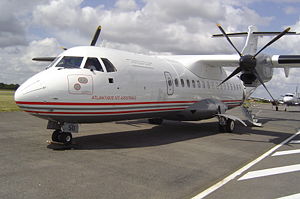
- Image via Wikipedia
Earlier today, September 13th, an ATR-42 turboprop crashed in Venezuela(More on that here). It seemed like a good time to share a few facts about the aircraft.
Last week, ATR made its 900th delivery, and expects to break 1000 within two years. The aircraft was received by their second largest customer, Brazil’s Trip Linhas Aereas, which operates 30 aircraft of both the ATR42 and ATR72 varieties. The first ATR 42 was delivered to Air Littoral in December of 1985.
The 42 in ATR-42 comes from its standard seating, which can vary from 40-52. The 72 is a stretched version of the aircraft that offers 68-74 seats and was introduced in 1989. Passengers are commonly boarded through the rear door, as opposed to the front door, although Finnair ordered ATR-72s with a front door in order to accommodate jet bridges.
The latest version, the ATR-72-600, will offer a variety of new comfort, operational, and efficiency improvements. The interior cabin on the ATRs offers a comfortable experience, from most reports(none of us have had the pleasure), with 2×2 seating and often have roughly the same seat width, if not pitch, as a larger jet aircraft.
ATR, which is a subsidiary of EADS(which also owns Airbus), currently has a firm backlog of over 150 of the turboprop aircraft. While not as well-known in the United States, with only about 100 in use, ATR’s CEO told the Associated Press last month that he is expecting a revival of turboprops on short haul routes such as New York-Washington when airlines look to replace older aircraft, and that the latest generation of fuel-efficient turboprops have addressed comfort and noise issues that had encouraged airlines to favor jets.
Related articles by Zemanta
- Azul Airlines inks $850-mln deal with ATR (marketwatch.com)
- ATR looks to US market for turbopropos (seattletimes.nwsource.com)
